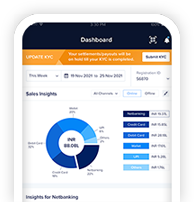NPCI enhances Fund Transfer through the launch of UPI 2.0
Since its inception in 2016, UPI transactions have increased to an impressive level. According to a report published by National Payments Corporation of India (NPCI), UPI based transactions done in July 2018 were 20 times higher than what was observed in the same month last year. UPI recordings showed transactions worth ![]() 45,845 crore in July 2018 as compared to last year's readings that stood at just
45,845 crore in July 2018 as compared to last year's readings that stood at just ![]() 6,947 crore. Following such an enormous expansion, NPCI has now made yet another move to stay ahead of the curve by launching UPI 2.0 which is an upgraded version of the interface. The latest version seems to be a catalyst of growth as it gives the users a totally enhanced experience through an array of advanced features and benefits.
6,947 crore. Following such an enormous expansion, NPCI has now made yet another move to stay ahead of the curve by launching UPI 2.0 which is an upgraded version of the interface. The latest version seems to be a catalyst of growth as it gives the users a totally enhanced experience through an array of advanced features and benefits.
What is UPI?
Unified Payments Interface or UPI is a real-time payment system that facilitates instant fund transfer between two bank accounts without the need of a beneficiary's account number. Through UPI, a user can link multiple bank accounts to a single mobile banking app and receive or request money through the same interface. NPCI which is an umbrella organization for all retail payments in the country, has developed UPI to facilitate inter-bank transactions.
How is UPI 2.0 Different?
Launched in August 2018, UPI 2.0 is the second version of the fund transfer platform. It supersedes the former version which was structured mainly to facilitate peer-to-peer transactions with a platform that also accommodates merchant payments. Through UPI 2.0, customers may be able to pre-authorize a transaction and pay on a later date. That said, there are multiple other features and benefits that the newly introduced upgrade seems to offer.
Key Features of UPI 2.0
-
One-time Mandate
Customers can now pre-authorize a transaction and pay on a later date with UPI mandate feature. These mandates are created with one-time block functionality for transactions that can be processed later while making a commitment at present. Individual users and merchants can benefit from these features tremendously, as mandates are generated instantly and payments get deducted automatically on the authorized date.
-
Invoice Verification
The new UPI 2.0 features dispatch of online invoice to the customer from the merchant. Now prior to making any payment, a customer can have a view of the order amount as well as other details that are important to verify the credentials of the merchant. After verifying the amount and other details, the customer can make his payment directly to the merchant.
-
Link an Overdraft Account
So far users were able to link their savings and current accounts to UPI. However, with the new upgrade they can also link their overdraft account to it and transact instantly. UPI 2.0 will now allow users to access their overdraft accounts and digitally channelize their payments. Also the transaction limit for UPI 2.0 has been raised from Rs 1 lakh to Rs 2 lakh.
-
Additional Security through Signed Intent and QR
While scanning a QR or Quick Response code, customers can check the authenticity of merchants. UPI 2.0 notifies the user with information to determine if the merchant is a verified UPI merchant or not. According to NPCI, the customers will be informed in case the receiver is not secured by way of notifications.
According to NPCI, State Bank of India (SBI), HDFC Bank, Axis Bank, ICICI Bank, IDBI Bank, RBL Bank, YES Bank, Kotak Mahindra Bank, IndusInd Bank, Federal Bank and HSBC are banks that are currently offering UPI 2.0. Other banks are also in the preparatory phase of launching the service soon.
While UPI 2.0 brings a lot of surprising benefits for customers as well as the merchants, this payments system lacks the crucial feature of automated recurring payments. This has apparently disappointed some of the major industry players as the presence of this feature could have enabled automated recurring payments from the user's bank account towards various digital services.
The launch of UPI 2.0 has been a significantly important event in further development of this payment system that was introduced two years ago. "With the launch of UPI 2.0 we hope to touch new milestones by expanding UPI's presence especially in person-to-merchant payment space" said Mr. Dilip Asbe, MD & CEO, NPCI.



















 INFIBEAM AVENUES
INFIBEAM AVENUES
